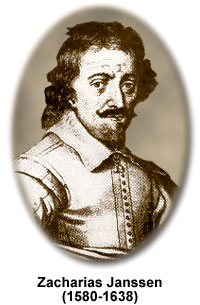Zacharias Janssen
(1580-1638)

Zacharias Janssen is generally believed to be the first investigator to invent the compound microscope. However, because the accomplishment is generally agreed among historians to be dated in the 1590s, most scholars believe that his father, Hans, must have played an important role in the creation of the instrument. The pair worked together as spectacle makers in Middleburg, Holland not far from Hans Lippershey, another optical scientist who is often alternatively credited with the invention of the microscope.
The Dutch diplomat William Boreel was a longtime acquaintance of Zacharias Janssen, who had written to him about the device in letters. Boreel saw the microscope for himself, but only years later when it had already fallen into the hands of another family friend, Cornelius Drebbel. When the physician of the French King publicly sought information regarding the origin of the microscope during the 1650s, Boreel responded, relating information about the Janssens and recounting the device they had created and his experience surrounding its use.
The device fashioned by the Janssens, and described by Boreel, rose vertically from a brass tripod shaped like dolphins and was almost two and a half feet long. The main brass tube was only an inch or two in diameter and held an ebony disc at its base and a lens at each end. However, in a Middleburg museum another microscope bears the Janssen name, but is of a different design. The museum instrument consists of three tubes, two of which are drawtubes that can slide into the third tube that acts as an outer casing. Lenses at the ends of each drawtube serve as magnifying elements. The lens connected to the eyepiece is bi-convex and the one serving as the objective is plano-convex. Capable of achieving a magnification range between three and nine times the true size of an object, the microscope was apparently built to be used by hand since it has no mounting mechanism.
Though rudimentary when compared with modern models, the Janssen microscope was an important advance from contemporary use of a single lens for magnification purposes. With further developments in microscopy, a formerly unknown and invisible world was to become readily apparent. By the end of the seventeenth century, Robert Hooke had employed his version of the compound microscope to observe organisms, such as fossils, diatoms, and even cells, and Marcello Malpighi had discovered capillaries. Modern compound light microscopes are able to reveal significantly many more wonders since, under optimal conditions, the instruments are capable of magnification ranges between 1000 and 2000 times specimen's true size.
Janssen's Microscope
The Janssen Drawtube Microscope - As discussed above, the origin of the optical microscope is a matter of debate, but most scholars agree that the invention of the compound microscope can be credited to Zacharias Janssen in the late sixteenth century. At that time eyeglasses were beginning to enjoy widespread use and this focused a great deal of attention on optics and lenses. The microscope illustrated in this section was built by Zacharias Janssen, probably with the help of his father Hans, in the year 1595.
